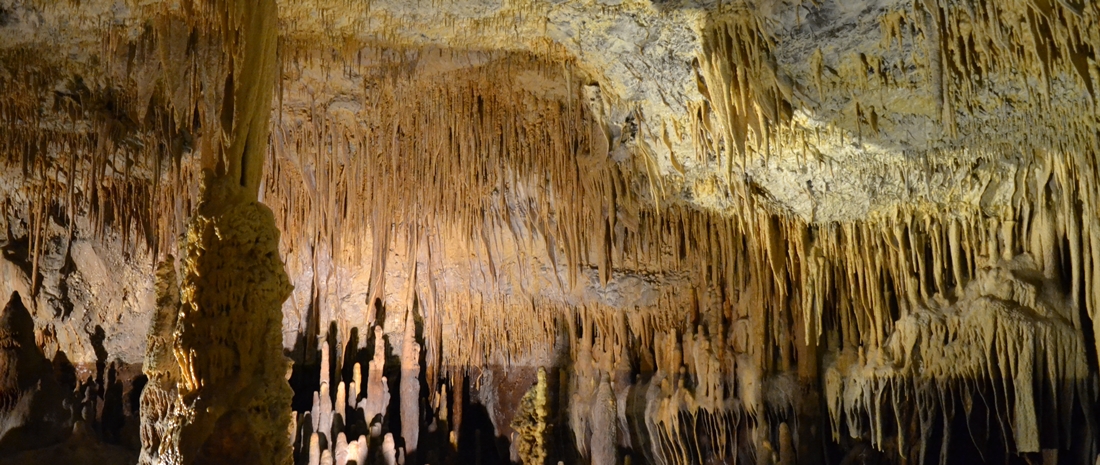KAPSIA

PLEASE NOTE THAT ALL THE PHOTOGRAPHS ON THE SITE ARE CLICKABLE LINKS

PLEASE NOTE THAT ALL THE PHOTOGRAPHS ON THE SITE ARE CLICKABLE LINKS
The cave of Kapsia is located at the foot of Mainalon Mountain, at an altitude of 637 meters, on the western part of the plain of ancient Mantinea. The cave is 16 km from the town of Tripoli and about 1.5 km north of the village of Kapsia.
It is a sinkhole belonging to the complex system beneath the Mantinea plateau. From a geographical point of view, the cave is horizontal and consists of a series of complex corridors of 600 m. in length with total area of 6,500 m2, leading to two rooms, the second of which is the larger.
It was first opened to the public in December 2010.
It should be noted that the ground at the entrance of the cave and almost up to the last big room is extremely muddy. This happens because during the period of heavy rainfall, a part of the waters of the Mantinea plateau are drained mainly through its first corridors, sweeping along sludge and other sediment.
It seems that in the past, the cave used to be flooded by rainwater and its first sections were underwater. This is shown by the traces of water level left by the floods on the walls of the cave. The natural entrances to the cave is situated outside where flood water can run out.
The Cave is one of the ten most impressive caves in Greece and ranks among the top 100 that are considered suitable for further exploration.
The first person to discover this beautiful cave was the French archaeologist Gustave Fougere in 1887 while he was carrying out excavations at ancient Mantinea.
The first survey of the cave was conducted on 20th August, 1892 by a French - Greek team headed by Nikolaos Sideridis, a state - employed engineer from Arcadia. Their published findings in 1911 brought the cave to the attention of the world.
Regarded as the most important Greek speliological discovery of its time, the study was the springboard for interest in the study of Greek caves.
In 1974 another French - Greek team led by I. loannou carried out further explorations at the site and discovered a new section of cave whose existence the first group of investigators had been unaware of.
Some of the rarest and most spectacular formations of colourful stalagmites in Greece's entire speleological kingdom so far explored are to be found in the named "Chamber of Wonders".
Fiery red, yellow ochre and aquamarine mingle with the snowy white configurations of stalactites, providing a remarkable exhibition of natural art.
I was taken on the tour, one my own as I was the only visitor, by a young lady who pointed out all the wonderful spectacles of the stalagmites and stalactites. Many of them are millions of years old - the cave is breathtaking.
The cave of Kapsia has great scientific interest apart from the touristic one. Numerous human bones of males, females and children were found inside the cave.
Along with the bones, many pieces of ancient pottery and clay oil lamps dating from the 4th and 5th centuries AD were also found.
The first explorers mention that they found 45-50 human skulls and bones most of which were gathered in an area almost in the middle of the cave which was named "The room of skulls and bones".
This photograph shows the bones of a young child with stalgmites having formed on the bones, there are also other human bones that have been left where they were found. Many of the bones are at a University in Athens where they are being studied.
The human skeletons, men, women and children, were concealed under a layer of mud half a metre thick which covered the floor of the cave. It is believed that the cave flooded and the people inside could not escape.
The origin of all this anthropological material remains a puzzle for science which has not found a satisfactory solution yet.
According to the opinions of Antonis Bartsioka, Kostas Merdenisianos and K Zafeiratos, (1981-82), the existence of the human remains is supposed to originate from the sudden drowning of people who occasionally used the cave (maybe for worshipping reasons) and who were trapped after a big flood.
Later research by Theodorus Pitsios, (1987-88), showed that the presence of paleoanthropological findings may not be due to some extraordinary event, as the one mentioned above, but to the long-term use of the cave as a burial spot and a place for worshipping the dead.
When I visited it was in February and I was the only one there so I had an individual tour. The tour guide (who spoke extremely good English) allowed me to take photographs without the use of flash and as you can see they are amazing!!
Opening Hours: 9:00 to 15:00. Tours are every half hour from 9.10 am. I am not sure of the cost of the tour.
Tel.: 6942 411384. Fax: 2710 243575